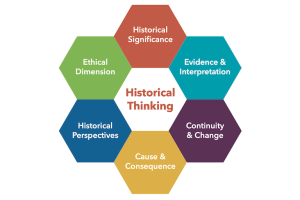Historical Thinking
As teachers of histories, we strongly support and advocate for the inclusion of historical thinking concepts in social studies classrooms across Canada. Historical thinking should be embedded in provincial curricula in order to ensure all teachers are utilizing these skills. Through the utilization of historical thinking and other critical thinking skills, history classes are an opportunity for student transformation. While the content of histories (the events, the dates, the individuals) are important, it is much more meaningful when students interpret, analyze and research historical information.
The Historical Thinking Project
The Historical Thinking Project was an initiative directed by Professor Peter Seixas at the University of British Columbia that developed an historical thinking framework that revolved around six historical thinking concepts. This work has permeated much of Canadian academia, is reflected in history curricula in most provinces, and is supported by many K-12 educators. The ideas emerging from this project have been articulated in the publication The Big Six which explores the concepts and provides guidance on how to use them effectively.
Main Concepts of Historical Thinking
- Establishing historical significance involves asking students to examine what we choose to remember and why.

- Using primary source evidence brings histories alive for students through authentic historical study.
- Identifying continuity and change is useful for developing a more sophisticated understanding of historical events.
- Analyzing cause and consequence involves exploring the reasons why events happen, the factors that contribute to them the results of historical events and how events often have unintended consequences.
- Taking a historical perspective involves students gaining an understanding of the different perspectives surrounding an historical event.
- Understanding the moral dimension in histories requires looking at events from the past and examining through a moral lens of the past rather than simply judging past events by today’s standards.
Using Historical Thinking in the Class
- It is important to recognize the contestability of historical events – that their significance may vary among groups and over time.
- The examination of one’s historical narrative should be common practice in the social studies classroom.
- Students should be challenged to create their own narratives, whereby they establish their identity, situate themselves in their own history and identify a reason for action.
- Teachers should encourage student agency, having them see themselves as part of the process of learning their histories.
